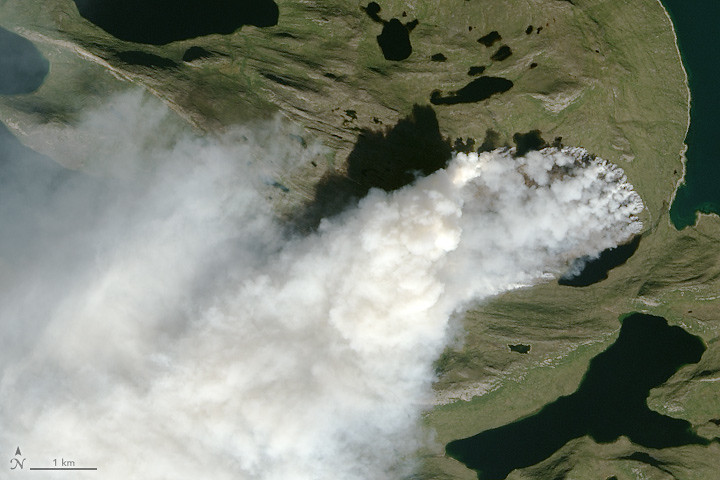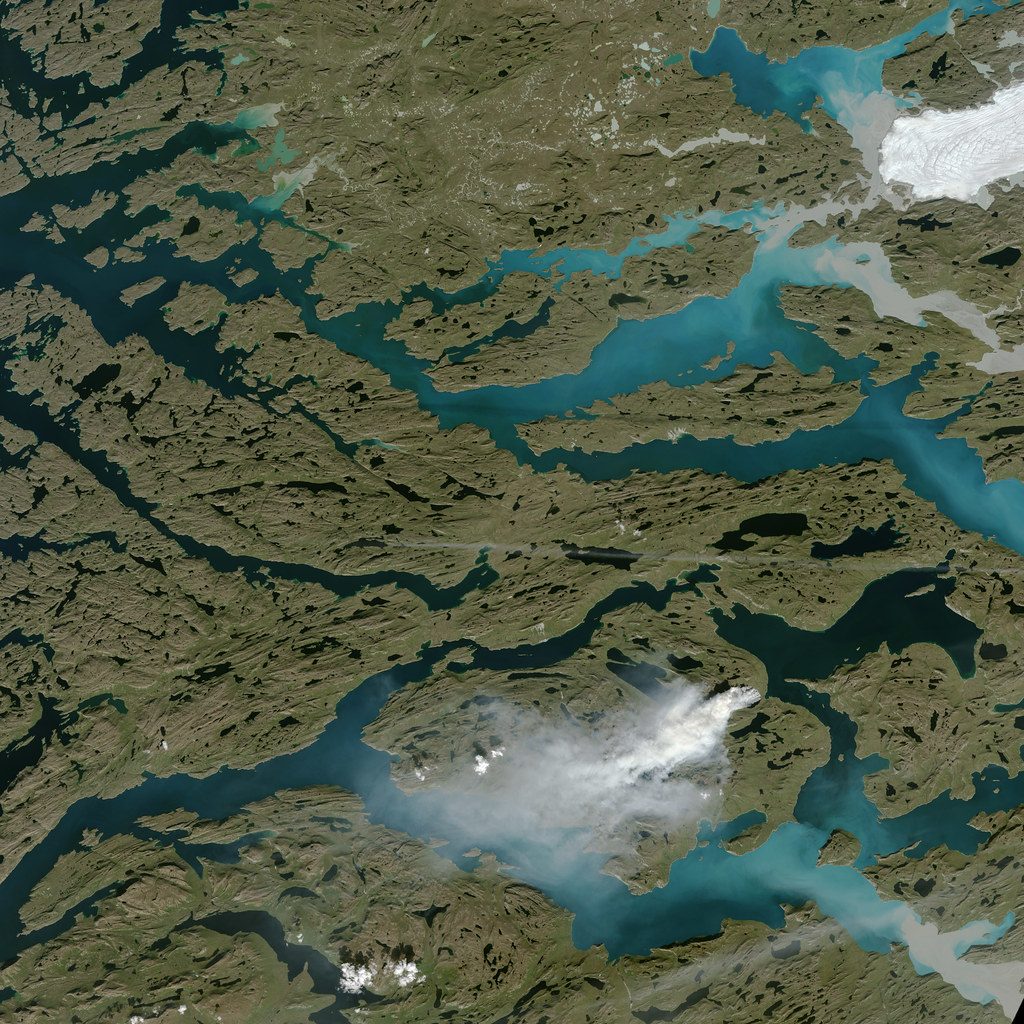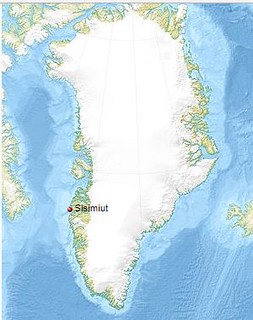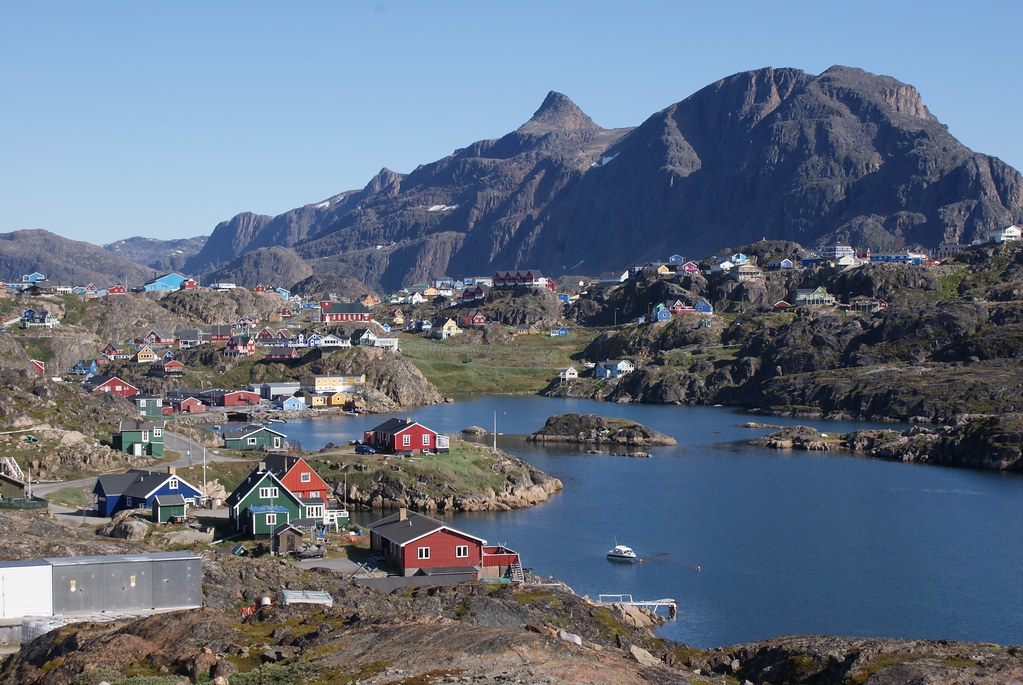以廣大冰蓋聞名的世界第一大島格陵蘭,近來首次經歷大規模野火,綿延島上第二大城西西米特(Sisimiut)東北部、西岸150公里。

7月31日衛星首次觀測到大火的跡象。美國太空總署(NASA)指出中等分辨率成像光譜儀(Moderate Resolution Imaging Spectroradiometer, MODIS)和索米國家極地軌道衛星的「可見紅外光影像輻射儀」(the Visible Infrared Imaging Radiometer Suite)在8月第一週的每日影像都可看到濃煙。
這並不是衛星首次在格陵蘭島上觀測到火事,但是根據荷蘭台夫特理工大學的初步分析,MODIS今年觀測到的次數遠多於2000年開始觀測以來的任何一年。
3/4的格陵蘭終年覆蓋冰雪,是南極以外唯一有永凍冰層的地方,西岸則是暴露於地表的高含碳量泥炭地。邁阿密大學科學家麥卡錫(Jessica McCarty)推測,野火似乎是在泥炭地上燃燒。
若真是如此,歐盟執委會哥白尼計畫大氣科學家帕靈頓(Mark Parrington)說,格陵蘭2017年的碳排放將會因此暴增。科學家擔心野火規模擴大的原因是永凍土融化,使底下的泥炭地很容易著火。泥炭地可作為燃料,可以燃燒很長一段時間。

丹麥氣象研究所學者莫特拉姆(Ruth Mottram)表示,研究所跟其他科學團體都沒有長期蒐集格陵蘭野火的資料,但所內許多氣象學家知道關於野火的軼事報導。
衛星在格陵蘭觀測到的大多是獵人或背包客升起的零星小營火。2015年8月地面衛星沒有捕捉到任何有規模的火事。
沒有人知道這次大規模野火真正的肇因,不過由於發生前並沒有閃電發生,只能猜測是人為。該區域常有馴鹿獵人出沒,而且接近有5600居民的西西米特。
2017年的夏季天氣乾燥,西西米特整個6月沒下雨,7月雨量只有過去的一半。科學家認為西岸枯萎的矮柳、灌木、草、苔蘚等植被都變得更加易燃,增加野火機率。

野火燃燒排放煤煙、黑炭,隨風往東吹,在格陵蘭冰蓋西緣形成一線黑色冰雪。
氣候科學家正積極觀察這個區域,因為黑色冰雪融化速度比白色快。
「在格陵蘭,一切事物同時在變暖:空氣、海面和海洋深處。我們不清楚哪些部分的暖化影響冰河最大。科學家只知道,北極升溫和格陵蘭冰蓋顏色變身造成夏季大量融冰,是格陵蘭海面上升的主因。」華盛頓大學冰河學家喬因(Ian Joughin)說,「格陵蘭現在夏季融冰期比1970年代早期多了70天。每年夏天,暖空氣融化近半個冰蓋。」
同時科學家們也正密切注意氣候變遷與野火的關係,以及對地球整體氣候的影響。
Greenland, the world’s largest island, known for its vast sheets of ice, is now experiencing its first large wildfire. The fire is burning along the island’s west coast about 150 kilometers (90 miles) northeast of Sisimiut, the second-largest city in Greenland, an autonomous county of Denmark.
Satellites first detected evidence of the fire on July 31. The U.S. National Aeronautic and Space Administration, NASA, says the Moderate Resolution Imaging Spectroradiometer (MODIS) and Visible Infrared Imaging Radiometer Suite on Suomi NPP collected daily images of smoke streaming from the fire over the first week in August.
While it is not unprecedented for satellites to observe fire activity in Greenland, a preliminary analysis by Stef Lhermitte of Delft University of Technology in the Netherlands suggests that MODIS has detected far more fire activity in Greenland in 2017 than it did during any other year since the sensor began collecting data in 2000.
Three-quarters of Greenland is covered by the only permanent ice sheet outside Antarctica. While Greenland is almost entirely covered by this thick ice sheet, there are exposed carbon-rich peatlands along the west coast.
The wildfire appears to be burning in peat, says Miami University scientist Jessica McCarty.
That would mean the fire produced a sharp increase in wildfire-caused carbon dioxide emissions in Greenland for 2017, says atmospheric scientist Mark Parrington of the European Commission’s Copernicus program.
Scientists fear that the fire may have broken out because permafrost is melting, making the underlying peat more likely to catch fire. Since peat can be used as a fuel, it could burn for a long time.
According to Ruth Mottram of the Danish Meteorological Institute, neither the institute nor other scientific groups maintain detailed records of fire activity in Greenland, but many meteorologists at the institute have heard anecdotal fire reports.
The small fires detected in Greenland by satellite are usually campfires lit by hunters or backpackers. But Landsat did capture imagery of another sizable fire in August 2015.
No one knows exactly what triggered this fire, though a lack of documented lightning prior to its ignition suggests the fire may have been sparked by human activity. The area is regularly used by reindeer hunters, and is close to Sisimiut, a town with a population of 5,600 people.
The summer of 2017 has been dry. Sisimiut saw almost no rain in June and half of the usual amount in July. Scientists speculate that may have parched dwarf willows, shrubs, grasses, mosses, and other vegetation that live in Greenland’s coastal areas, making them more likely to burn.
Fires emit soot, black carbon. The prevaling winds are likely to transport some of this material eastward where it will contribute to a line of darkened snow and ice along the western edge of Greenland’s ice sheet.
Climate scientists are watching this area closely because darkened snow and ice melts more rapidly than when it is white.
“In Greenland, everything got warmer at the same time: the air, the ocean surface, the depths of the ocean,” said Ian Joughin, a glaciologist at University of Washington. ‘We don’t really understand which part of that warming is having the biggest effect on the glaciers. What scientists do know is that warming Arctic temperatures – and a darkening surface of the Greenland ice sheet – are causing so much summer melting that it is now the dominant factor in Greenland’s contribution to sea level rise.”
“Greenland’s summer melt season now lasts 70 days longer than it did in the early 1970s. Every summer, warmer air temperatures cause melt over about half of the surface of the ice she,” said Joughin.
Scientists are closely monitoring the contributions of climate change to the start of this fire and also its impacts on the Earth’s climate as a whole.
※ 全文及圖片詳見:ENS











